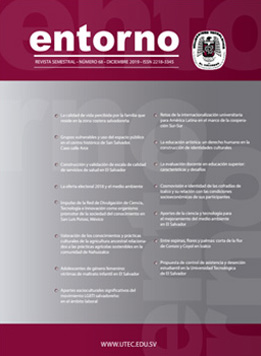Published 2019-12-30
Copyright (c) 2019 Entorno

This work is licensed under a Creative Commons Attribution-NonCommercial-ShareAlike 4.0 International License.
How to Cite
Abstract
Numerous studies indicate that violence in El Salvador not only decreases, but that, on the contrary, it also increases regardless of what the State points out: “girls, boys and adolescents must be treated with respect, and must not be subjected to physical or psychological punishments, nor to any other form of abuse (…).” (UTE, 2011, p. 20) In this sense, the objective of this study, was to identify child abuse situations in adolescents ranging between the ages of 13 and 15. The study was conducted within the framework of the project “Fortaleciendo la Colaboración en las Américas sobre Derechos de la Niñez y la Adolescencia” (Rights for Children and Youth Partnership, RCYP) The research was conducted under the quantitative paradigm, typical of the deductive method, and from a gender perspective, based on the analysis of the measurements made to the different forms of abuse towards adolescents. A survey was used in congruency to this method; the questionnaire was conducted with 384 adolescents who were selected via a probabilistic sampling, in the three areas of the country (western, central and eastern). This study points out that child abuse continues to be a form of violence more frequently exerted against women, since during 2018 two out of three beaten adolescents turned out to be female.
Keywords: Child violence – El Salvador, Child abuse – El Salvador, Social problems – El Salvador.
DOI: https://doi.org/10.5377/entorno.v0i68.8458
URI: http://hdl.handle.net/11298/1138
References
- CONNA. (2013). Recopilación de normativa de niñez y adolescencia en El Salvador. San Salvador, El Salvador: Contracorriente editores.
- DIGESTYC. (2013). Resultados encuesta de hogares de propósitos múltiples 2013 [versión de Adobe Acrobat Reader]. Recuperado de http://www.digestyc.gob.sv/EHPM2013/DIGESTYC/presentacion.pdf
- Garbarino, J., Guttman, E. y Seeley, J. (1989). The psychologically battered child. Strategies for identification, assessment and intervention (4ta Ed.). San Francisco, EE.UU: Jossey-Bass Inc.
- Hernández Miranda, J. E. (2012). Características psicosociales de niños/as que experimentan maltrato infantil de 7-9 años del 1° ciclo de la Escuela Dr. José Rosa Pacas, del municipio de San Vicente, departamento de San Vicente en el período comprendido de mayo 2010 a septiembre 2012 (Tesis de pregrado). Universidad de El Salvador, El Salvador.
- Soriano Faura, F. J. (2015). Promoción del buen trato y prevención del maltrato en la infancia en el ámbito de la atención primaria de la salud [versión de Adobe Acrobat Reader]. Recuperado de http://previnfad.aepap.org/sites/default/files/2017-04/previnfad_maltrato.pdf
- Unicef. (2014). Informe de situación de la niñez y adolescencia en El Salvador 2014: Transformar inequidades en oportunidades para todas las niñas, niños y adolescentes. Recuperado de https://www.unicef.org/elsalvador/informes/informe-de-situaci%C3%B3n-de-la-ni%C3%B1ez-y-adolescencia-en-el-salvador-2014
- Unicef. (2018). Disciplina violenta en América Latina y el Caribe: Un análisis estadístico 2018. Recuperado de https://www.unicef.org/lac/informes/disciplina-violenta-en-am%C3%A9rica-latina-y-el-caribe
- Unicef. (s.f.). Ocultos a plena luz: Un análisis estadístico de la violencia contra los niños [versión de Adobe Acrobat Reader]. Recuperado de https://www.unicef.org/ecuador/ocultos-a-plena-luz.pdf
- Unidad Técnica Ejecutiva. (2011). Ley de Protección Integral de la Niñez y Adolescencia (LEPINA). Recuperado de http://www.ute.gob.sv/index.php/tema/2014-12-01-01-40-25/2019-01-16-21-52-11/lepina.html
